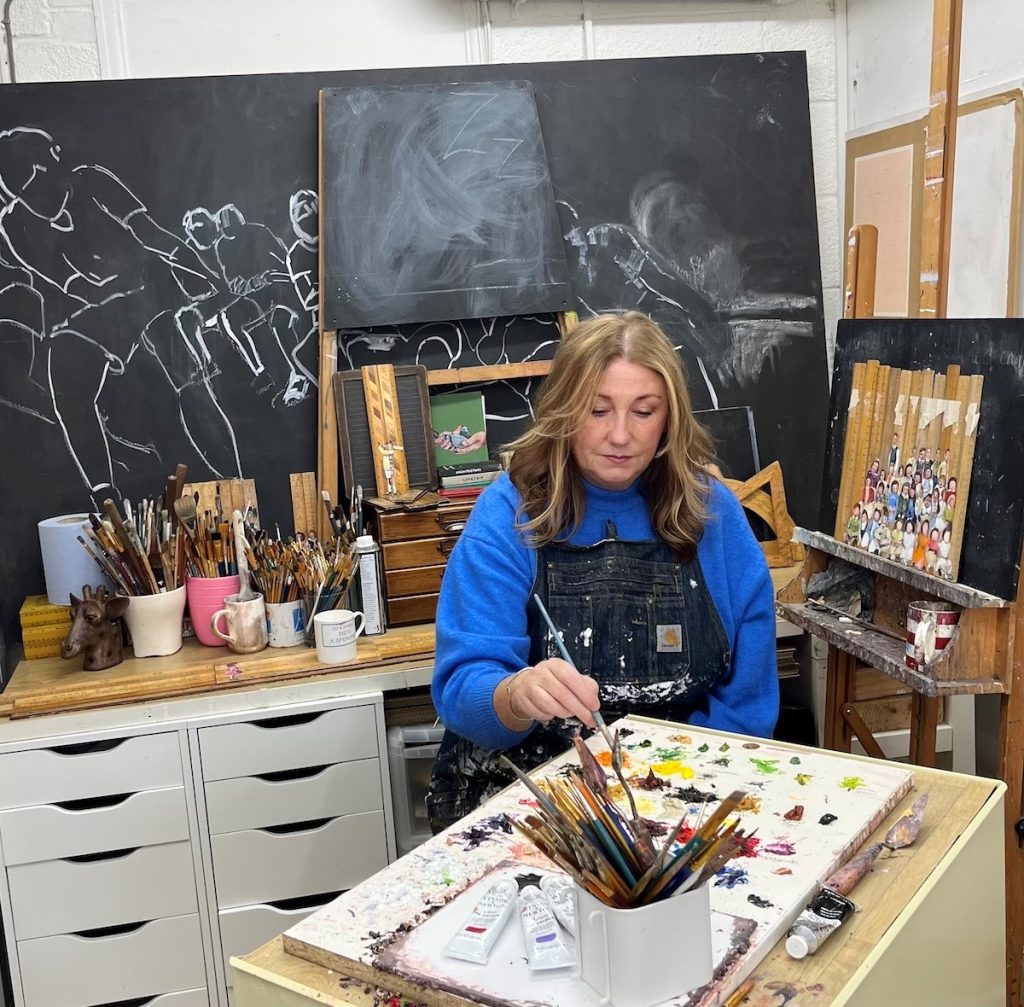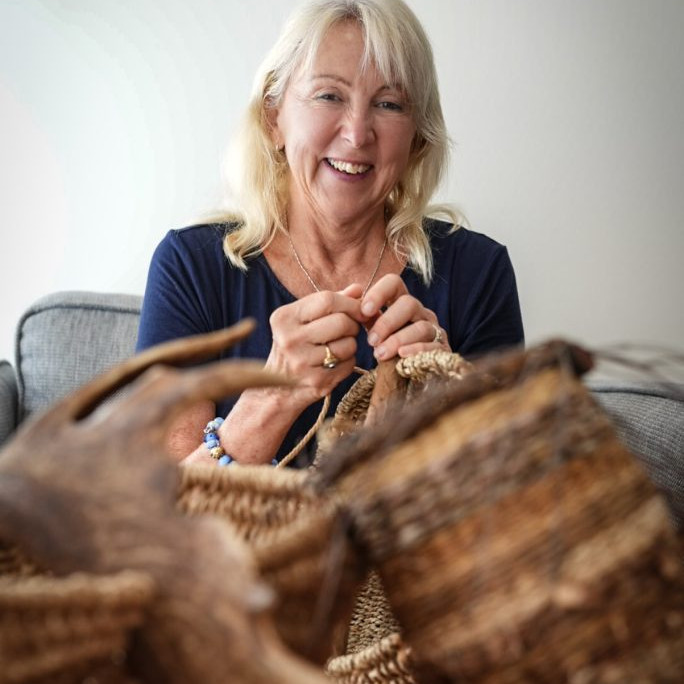Lindsay Madden Painter / Mixed Medium
When did you become interested in using childhood in your work?
During my time at university, I experimented with using photographic imagery in my work, initially collaging images from different eras to create new narratives. It was while I was trawling through family of my own childhood and my children’s that I was drawn to the universal and timeless quality of children’s body language; there is observing/perceiving an honesty to it, that is not always visible in adults.
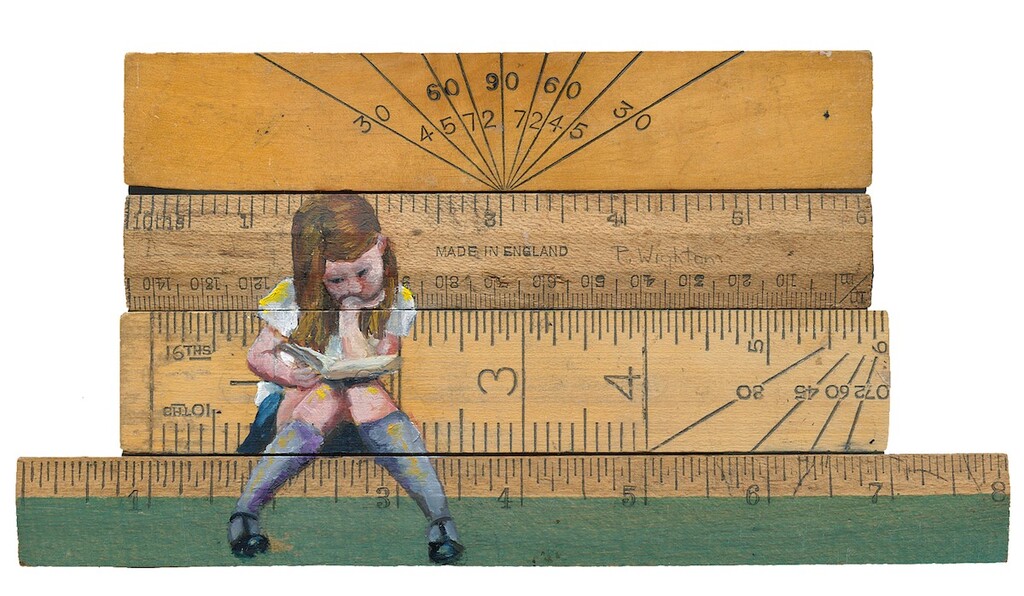
‘Short Stories’
How and why have you gone beyond recording your own children and developing your own medium?
In truth I pretty much exhausted my own family photo albums, friends were king enough to let me loose with their albums. I now find using found photographs gives me a sense of freedom, without knowledge of their past makes it much easier to respond the body language and invent my own narratives.
Use Two rulers and discuss the body language in them.
‘Stretched’ was one of my first paintings on rulers, it was part of my degree show.

‘Stretched’
The little figure reaching up perfectly reflected my feelings at that time. I was essentially back at school, still growing, academically and mentally rather than physically, being stretch in so many different areas, juggling busy homelife, parttime job and life as a mature student, at the same time, my capabilities were still being measured.
‘Another Perspective’ is a piece that holds a special place for me. The curious little figure, checking out her subject, from an unusual angle, sums up the childhood connection to being an artist, the desire to see the world in a different way. The lack of self-awareness embodies the honesty of children’s body language which appeals to me.
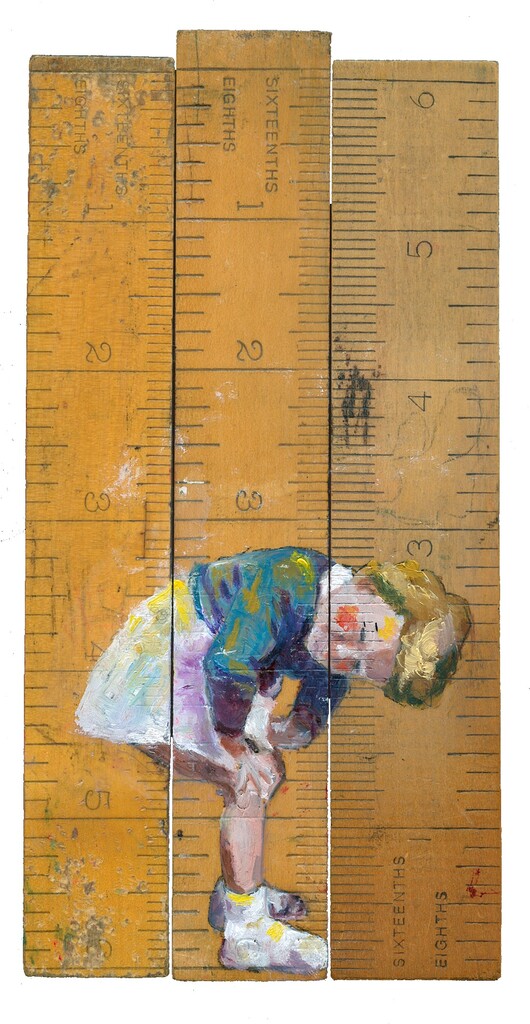
‘Another Perspective’
What lead you to use vintage ruler and blackboards?
I’ve always preferred painting onto a wooden surface, rather than a canvas. Exploring the theme of childhood and its transient nature led me to consider how quickly children grow and how we record that. Height charts sprang to mind, which in turn lead me to school rulers, mini height charts, and in turn the possibilities of other school equipment such as protractors and chalkboards.
Discuss ‘Round in Circles’ and ‘One Size Fits All’ and your use of many children together.
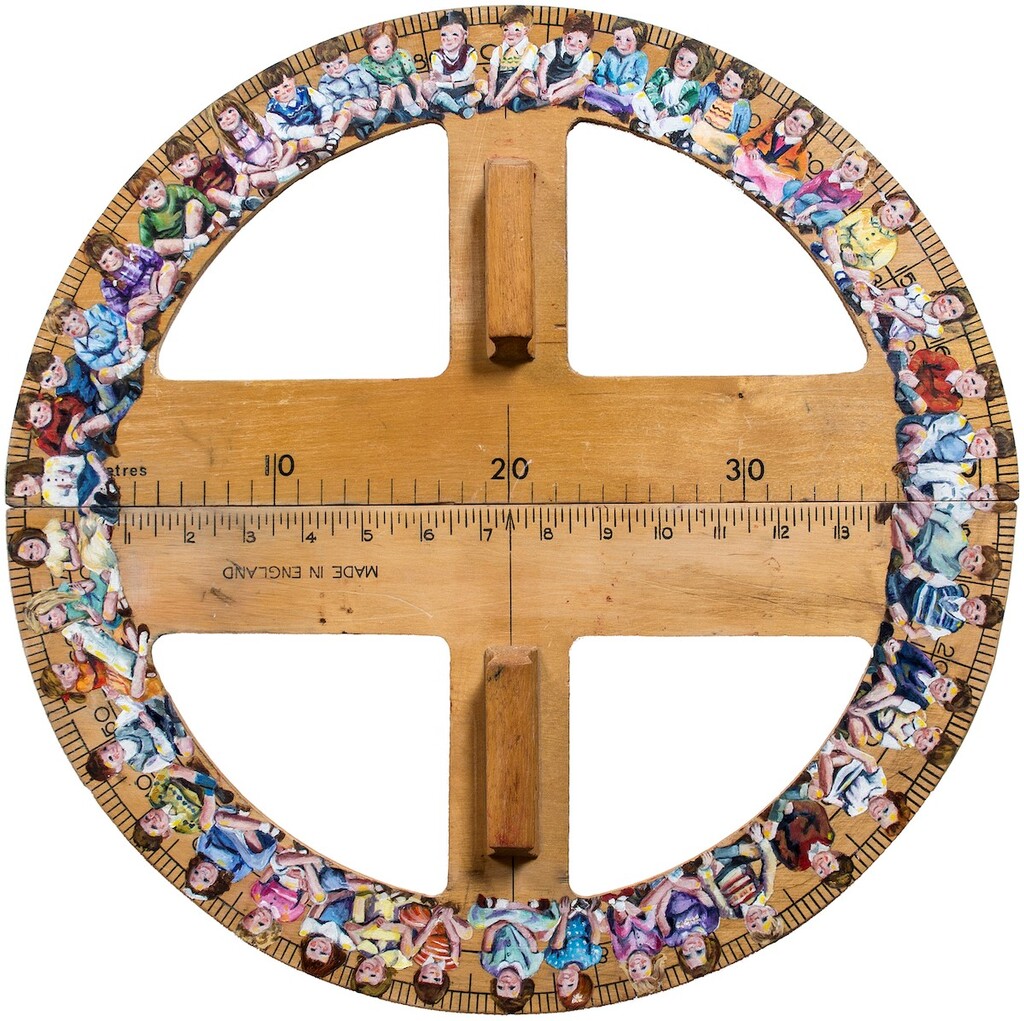
‘Round in Circles’
I’d managed to collect several large wooden teacher’s protractors and was interested in the way they fit together to form a circle, which reminded me sitting in a circle to play the children’s party game ‘pass the parcel’. I wanted to squeeze as many little characters into the composition as possible as that cramped environment is how I remembered playing that game, the feeling of excited eagerness to get your hands on the parcel. I felt that the title ‘Round in Circles’ was a metaphor that could be applied to adult life, when you can feel there is a relentless lack of progress. I’ve always felt frustrated with our education system that takes a ‘One Size Fits All’ approach, and the preoccupation with measuring performance. The piece comments on the notion of school uniform making everyone the same but the fit is always different as no two children are the same.
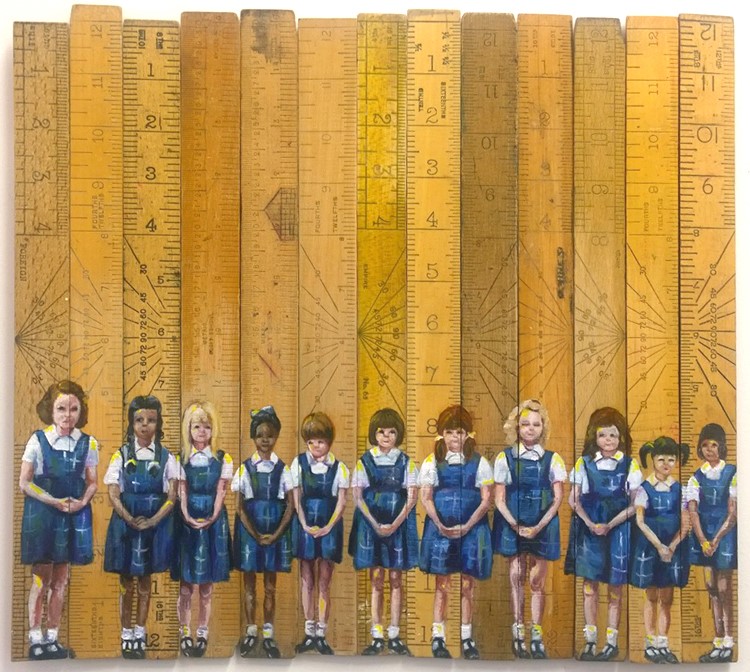
‘One Size Fits All’
Does your work take us back in time? Eg ‘Close Knit’
There is a definite nostalgic feel to the work with those home knits and retro outfits, and the well-worn vintage rulers that have been handled through generations. My hope is that although figures have a nod to the past, the narratives and titles are relatable to present times, ‘Close Knit’ comments on those special bonds of friendship that can be formed during school years.
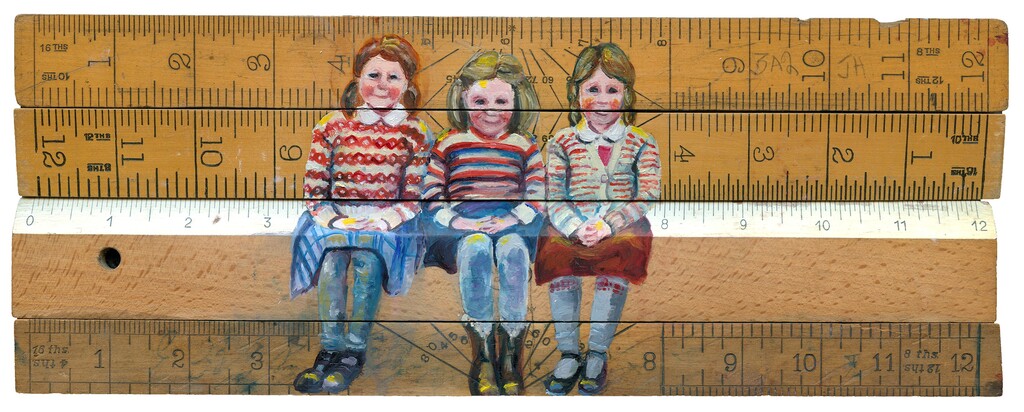
‘Close Knit’
Do people purchase your work both for the painting and their own memories?
It has often been commented by people who have seen my work that they enjoy being nudged into their own memories of childhood. By setting the figures within a context that is both familiar and ambiguous it allows the viewer room for their own experiences and memories to breathe. Galleries and social media suggest that the work has been a great conversation starter for viewers to take a trip down memory lane, whether it’s the recollection of the wooden rulers, the activity of the children in the painting, or some item of clothing, are able to see both themselves and their own children.
How many rulers have you put together for one of your larger paintings?
One of the largest compositions of multiple rulers together is a recent painting ‘The Long and the Short’ which is made up from fourteen rulers placed vertically together.I have also used yardstick and metre rules, (e.g., Pull Together’) which took the alternative canvas size to 100cm.

’Pull Together’
Not all of your work is just children, comment on ‘Temporary Measure’
‘Temporary Measure’ is a very early personal piece that was inspired by a cherished photo of myself as a child with my stepfather. In recent years I’ve chosen to focus primarily on children, opting to keep compositions simple, keeping observations of relationships between the little characters themselves.
 ‘Temporary Measure’
‘Temporary Measure’
How do you come up with all the individual titles?
I aim to look for titles that can work on several levels, something that can be taken at face value and can be interpreted on a deeper level. Sometimes a piece can start with a title, sometimes it is inspired by a photographic image or simply an idea and the titles come when the work is finished, but it’s always on the tip of my tongue.
You don’t have as many protractors, is this because there are not as many available?
Yes, exactly that, they are much more difficult to find.
The chalkboard paintings are those done on the old individual school boards.
Some of the chalkboard paintings are painted on vintage slates, or vintage children’s chalkboard easels. The very large scale 6feet x 4feet pieces are boards I have mad myself to echo those classroom chalkboards from my school days.
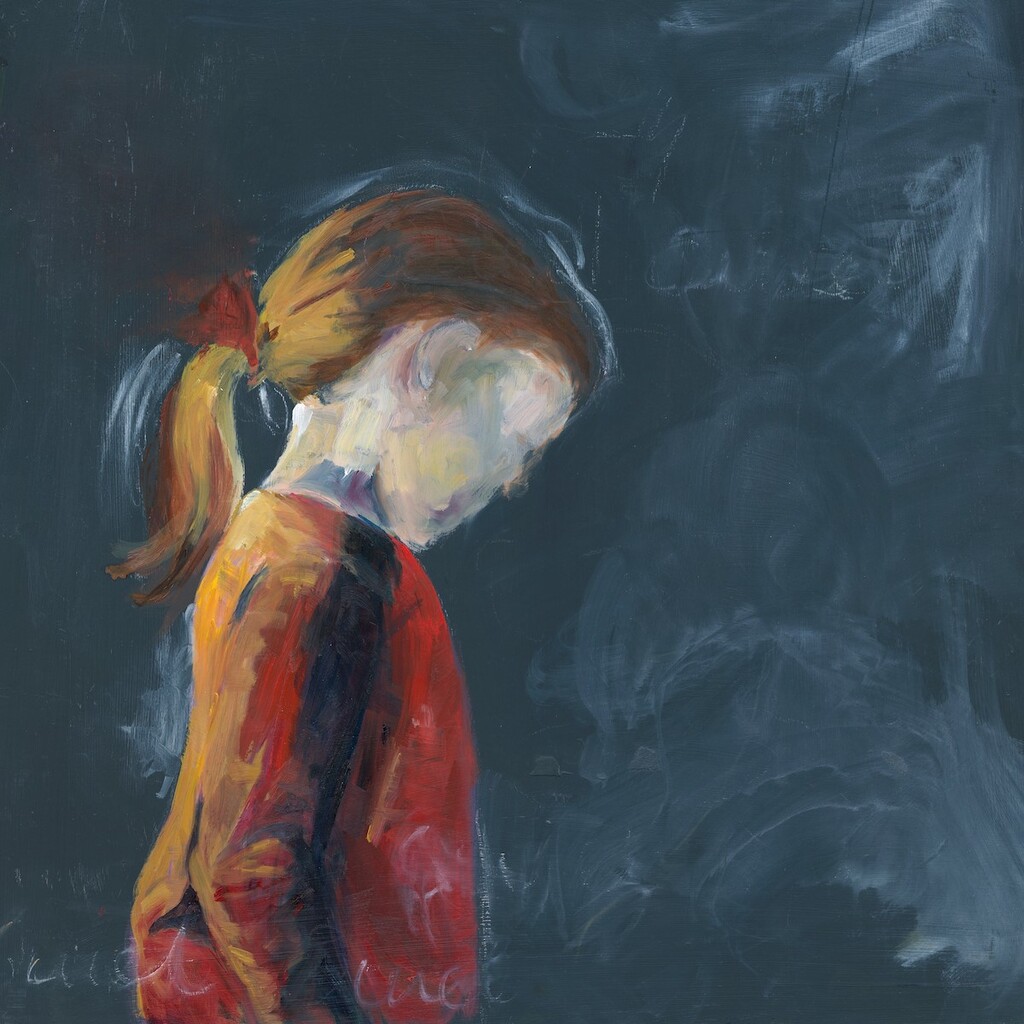 ‘Quiet, Painted on Chalkboard’
‘Quiet, Painted on Chalkboard’
Your children are depicted in the most casual manner, so different from studio photographs of well combed perfect children. Discuss, Equal Measure.
 ‘Equal Measure’
‘Equal Measure’
My interest lies in the uninhibited freedom of children. I enjoy juxtaposing the freedom that children feel while playing, throwing handstands and cartwheels etc against the confines of the rigid limitations of the ruler.
Can you explain more about your Observer Books?
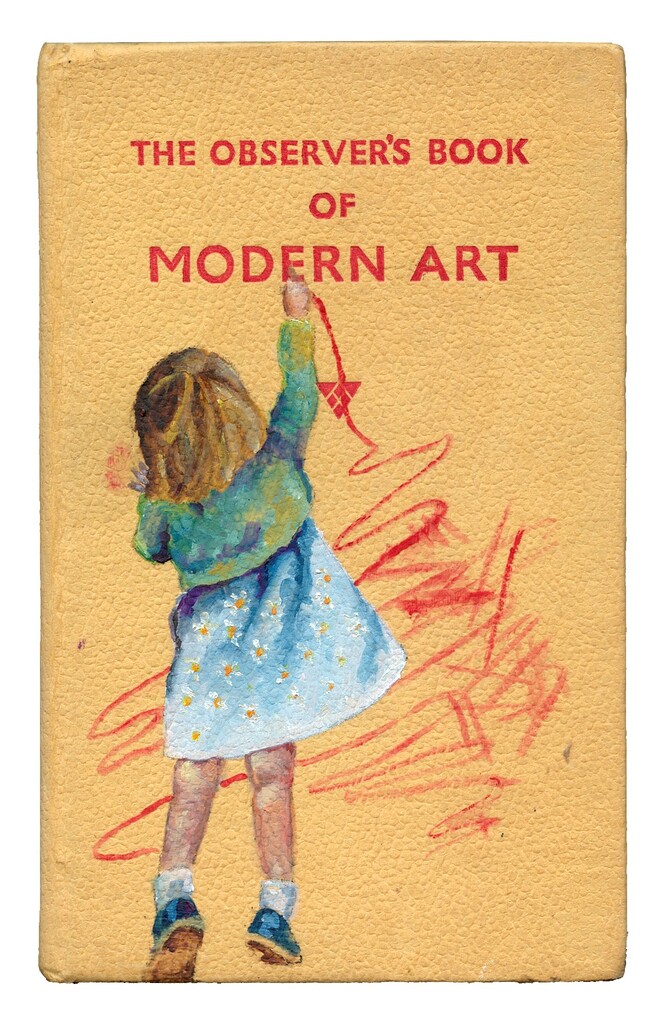 ‘Red Handed’
‘Red Handed’
The aged appeal of those well-thumbed Observer books that boast a wealth of knowledge, offer an irresistible alternative canvas. The tactile familiarity offers the perfect backdrop for the playful interpretations of their subjects. Their colourful covers contrasting with the bold type face of the title form an integral part of the gently mischievous compositions, nostalgic loosely painted figures aiming to bring a smile to the viewer.
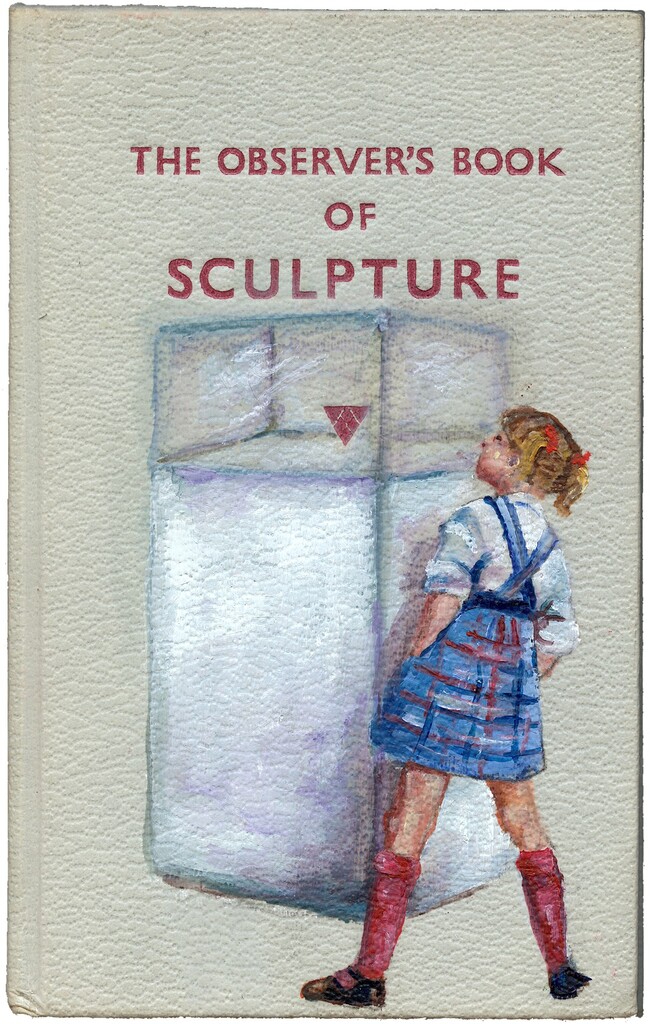 ‘Look Don’t Touch’
‘Look Don’t Touch’
Discuss your relation to the way we need to continually measure Children both at home and school.
Theodore Roosevelt once said that ‘comparison is the thief of joy’ yet as a society we have preoccupation with measurement. From the moment we are born a plethora of statistics are recorded, weight, length, head circumference etc. Throughout life we have this compulsion to measure and compare, we’re constantly on a path to hit relentless milestones, our schooldays especially burdened with all aspects of measurements, physically, mentally, academically and against siblings and peers.
Contact:
Lindsay Madden
lindsaymadden21@gmail.com
www.lindsaymadden.com
Deborah Blakeley, Melbourne, Australia
Interview by Deborah Blakeley, May 2023
Think a colleague or friend could benefit from this interview?
Knowledge is one of the biggest assets in any business. So why not forward this on to your friends and colleagues so they too can start taking advantage of the insightful information the artist has given?
Other artists you may be interested in:


